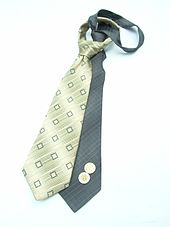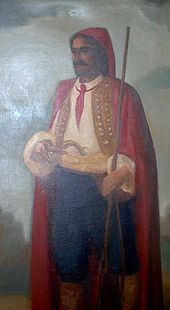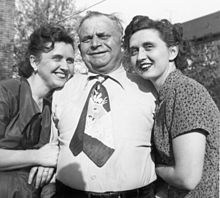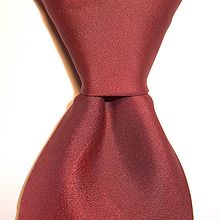- Necktie
-
For the grappling position, see double collar tie.
A necktie (or tie) is a long piece of cloth worn for decorative purposes around the neck or shoulders, resting under the shirt collar and knotted at the throat. Variants include the ascot tie, bow tie, bolo tie, and the clip-on tie. The modern necktie, ascot, and bow tie are descended from the cravat. Neck ties are generally unsized, but may be available in a longer size. Men and boys wear neckties as part of regular office attire or formal wear. Neckties can also be worn as part of a uniform (e.g. military, school and waitstaff), whereas some choose to wear them as everyday clothing attire. Neckties are traditionally worn with the top shirt button fastened, and the tie knot resting comfortably between the collar points. However, it has become common in recent times for neckties to be worn as a casual item, tied loosely around the neck, nearly always with one or several buttons unfastened.
Contents
History
Origins
- For the history of the tie, see also Cravat.
The necktie traces back to the time of Thirty Years' War (1618–1648) when Croatian mercenaries from the Croatian Military Frontier in French service, wearing their traditional small, knotted neckerchiefs, aroused the interest of the Parisians. Due to the slight difference between the Croatian word for Croats, Hrvati, and the French word, Croates, the garment gained the name "cravat".[1] The new article of clothing started a fashion craze in Europe where both men and women wore pieces of fabric around their necks. In the late 17th century, the men wore lace cravats that took a large amount of time and effort to arrange. These cravats were often tied in place by cravat strings, arranged neatly and tied in a bow.
1650–1720: the Steinkirk
The Battle of Steenkerque took place in 1692. In this battle, the princes, while hurriedly dressing for battle,[dubious ] just wound these cravats around their necks. They twisted the ends of the fabric together and passed the twisted ends through a jacket buttonhole. These cravats were generally referred to as Steinkirks.
1720–1800: stocks, solitaires, neckcloths, cravats
In 1715, another kind of neckwear, called "stocks" made its appearance. Stocks were initially just a small piece of muslin folded into a narrow band wound a few times round the shirt collar and secured from behind with a pin. It was fashionable for the men to wear their hair long, past shoulder length. The ends were tucked into a black silk bag worn at the nape of the neck. This was known as the bag-wig hairstyle, and the neckwear worn with it was the stock.
The solitaire was a variation of the bag wig. This form had matching ribbons stitched around the bag. After the stock was in place, the ribbons would be brought forward and tied in a large bow in front of the wearer.
Sometime in the late 18th century, cravats began to make an appearance again[where?]. This can be attributed to a group of young men called the macaronis (of "Yankee Doodle" fame). These were young Englishmen who returned from Europe and brought with them new ideas about fashion from Italy. The French contemporaries of the macaronis were the incroyables.
1800–1850: cravat, stocks, scarves, bandannas
At this time, there was also much interest in the way to tie a proper cravat and this led to a series of publications. This began with Neckclothitania, which is a book that contained instructions and illustrations on how to tie 14 different cravats. It was also the first book to use the word ‘tie’ in association with neckwear.
It was about this time that black stocks made their appearance. Their popularity eclipsed the white cravat, except for formal and evening wear. These remained popular through to the 1850s. At this time, another form of neckwear worn was the scarf. This was where a neckerchief or bandanna was held in place by slipping the ends through a finger or scarf ring at the neck instead of using a knot. This is the classic sailor neckwear and may have been adopted from them.
1860–1920s: bow ties, scarf/neckerchief, the ascot, the long tie
The industrial revolution created a need for neckwear that was easy to put on, comfortable and would last an entire workday. The modern necktie, as is still worn by millions of men today, was born. It was long, thin and easy to knot and it did not come undone.
There is no clear documentation as to why the knot became known as the “four in hand”. Common theories are that the resembled the reins of the four horse carriage used by the British upper class. Others that the know was adopted by the Four-In-Hand Driving Company (a London club founded in 1856 which is alleged to have adopted the necktie.) By this time, the sometimes complicated array of knots and styles of neckwear gave way to the neckties and bow ties, the latter a much smaller, more convenient version of the cravat. In formal dinner parties and when attending races, another type of neckwear was considered de rigueur; this was the Ascot tie, which had wide flaps that were crossed and pinned together on the chest.
This was until 1926, when a New York tie maker, Jesse Langsdorf came up with a method of cutting the fabric on the bias and sewing it in three segments. This technique improved elasticity and facilitated the fabric's return to its original shape. Since that time, most men have worn the “Langsdorf” tie. Yet another development of that time was the method used to secure the lining and interlining once the tie had been folded into shape. Richard Atkinson and Company of Belfast claim to have introduced the slipstitch for this purpose in the late 1920s.
1920s – present day
After the First World War, hand-painted ties became an accepted form of decoration in America. The widths of some of these ties went up to 4.5 inches (11 cm). These loud, flamboyant ties sold very well all the way through the 1950s.
In Britain, regimental stripes have been continuously used in tie designs at least since the 1920s. Some reports say that British school, college, university, and regimental ties date back to the 1880s. In Commonwealth countries, necktie stripes run from the left shoulder down to the right side. Some[who?] say this choice was made because the stripe runs from a person's heart down to their right (sword) hand. In Commonwealth countries, normally only people affiliated with a regiment (or university, school or organisation) will wear a necktie affiliated with that regiment (or university, college, school, or other organisation). When Brooks Brothers introduced similar striped ties in the United States around the beginning of the 20th century, they had their stripes run from the right shoulder to the left side, in part to distinguish them from British regimental (and organisational, school and university) striped neckties. In the United States, some 'regimental'-style ties, where the stripe of the tie is modeled on the official ribbon associated with an official medal of the US Armed Forces or where the design of the tie otherwise includes the official symbol of a particular military unit or military service, also exist but they are less common than in Commonwealth countries.[2] These US regimental-style ties run from the right shoulder to the lower left side.
Before the Second World War ties were worn shorter than they are today; this was due, in part, to men wearing trousers at the natural waist (more or less at the level of the belly button), and also due to the popularity of vests, where tie length is not important as long as the tips are concealed. Around 1944, ties started to become not only wider, but wilder. This was the beginning of what was later labeled the Bold Look: ties which reflected the returning GIs' desire to break with wartime uniformity. Widths reached 5 inches (13 cm), and designs included Art Deco, hunting scenes, scenic "photographs", tropical themes, and even girlie prints, though more traditional designs were also available. The typical length was 48 inches (120 cm).
The Bold Look lasted until about 1951, when the "Mister T" look (so termed by Esquire magazine), was introduced. The new style, characterized by tapered suits, slimmer lapels, and smaller hat brims, included thinner and not so wild ties. Tie widths slimmed to 3 inches (7.6 cm) by 1953 and continued getting thinner up until the mid-1960s; length increased to about 52 inches (130 cm) as men started wearing their pants lower, closer to the hips. Through the 1950s, neckties remained somewhat colorful, yet more restrained than in the previous decade. Small geometric shapes were often employed against a solid background (i.e., foulards); diagonal stripes were also popular. By the early 1960s, dark, solid ties became very common, with widths slimming down to as little as 1 inch (2.5 cm).
The 1960s brought about an influx of pop art influenced designs. The first was designed by Michael Fish when he worked at Turnbull & Asser, and was introduced in Britain in 1965; the term Kipper tie was a pun on his name. The exuberance of the styles of the late 1960s and early 1970s gradually gave way to more restrained designs. Ties became wider, returning to their 41⁄2-inch (11 cm) width, sometimes with garish colors and designs. The traditional designs of the 1930s and 1950s reappeared, particularly Paisley patterns. Ties began to be sold along with shirts, and designers slowly began to experiment with bolder colors.
In the 1980s, narrower ties, some as narrow as 11⁄2 inches (3.8 cm) but more typically 3 to 31⁄4 inches (7.6 to 8.3 cm) wide, became popular again. Into the 1990s, as ties got wider again, increasingly unusual designs became common. Novelty (or joke) ties or deliberately kitschy ties designed to make a statement gained a certain popularity in the 1980s and 1990s. These included ties featuring cartoon characters, commercial products, or pop culture icons, and those made of unusual materials, such as plastic or wood. During this period, with men wearing their pants at their hips, ties lengthened to 57 inches (140 cm).
At the start of the 21st century, ties widened to 31⁄2 to 33⁄4 inches (8.9 to 9.5 cm) wide, with a broad range of patterns available, from traditional stripes, foulards, and club ties (Ties with a crest or design signifying a club, organization, or order) to abstract, themed, and humorous ones. The standard length remains 57 inches (140 cm), though other lengths vary from 117 cm to 152 cm. While ties as wide as 33⁄4 inches (9.5 cm) inches are still available, ties under 3 inches (7.6 cm) wide also became popular, particularly with younger men and the fashion-conscious. In 2008 and 2009 the world of fashion saw a return to narrower ties.
Types
Cravat
In 1660, in celebration of its hard-fought victory over the Ottoman Empire, a crack regiment from Croatia visited Paris. There, the soldiers were presented as glorious heroes to Louis XIV, a monarch well known for his eye toward personal adornment. It so happened that the officers of this regiment were wearing brightly colored handkerchiefs fashioned of silk around their necks. These neck cloths struck the fancy of the king, and he soon made them an insignia of royalty as he created a regiment of Royal Cravattes. The word "cravat" is derived from the à la croate—in the style of the Croats.
Four-in-hand
The four-in-hand necktie (as distinct from the four-in-hand knot) was fashionable in Great Britain in the 1850s. Early neckties were simple, rectangular cloth strips cut on the square, with square ends. The term "four-in-hand" originally described a carriage with four horses and a driver; later, it also was the name of a London gentlemen's club. Some etymologic reports are that carriage drivers knotted their reins with a four-in-hand knot (see below), whilst others claim the carriage drivers wore their scarves knotted 'four-in-hand', but, most likely, members of the club began wearing their neckties so knotted, thus making it fashionable. In the latter half of the 19th century, the four-in-hand knot and the four-in-hand necktie were synonymous. As fashion changed from stiff shirt collars to soft, turned-down collars, the four-in-hand necktie knot gained popularity; its sartorial dominance rendered the term "four-in-hand" redundant usage, shortened "long tie" and "tie."
In 1926, Jesse Langsdorf from New York introduced ties cut on the bias (US) or cross-grain (UK), allowing the tie to evenly fall from the knot without twisting; this also caused any woven pattern such as stripes to appear diagonally across the tie.
Today, four-in-hand ties are part of men's dress clothing in both Western and non-Western societies, particularly for business.
Four-in-hand ties are generally made from silk or polyester. Another material common before World War II but not as popular nowadays, wool. More recently,[when?] microfiber ties have also appeared; in the 1950s and 1960s, other manmade fabrics, such as Dacron and rayon, were also used, but have fallen into disfavor. Modern ties appear in a wide variety of colours and patterns, notably striped (usually diagonally); club ties (with a small motif repeated regularly all over the tie); foulards (with small geometric shapes on a solid background); paisleys; and solids. Novelty ties featuring icons from popular culture (such as cartoons, actors, or holiday images), sometimes with flashing lights, have enjoyed some popularity since the 1980s.
Six- and seven-fold ties
A seven-fold tie is an unlined construction variant of the four-in-hand necktie which pre-existed the use of interlining. Its creation at the end of the 19th century is attributed to the Parisian shirtmaker Washington Tremlett for an American customer.[3] A seven-fold tie is constructed completely out of silk. It is cut from a single piece of silk and asymmetrically folded seven times onto itself. The traditional seven-fold is untipped and unlined.[4]
A six-fold tie is a modern alteration of the seven-fold tie. This construction method is more symmetrical than the true seven-fold. It has a interlining which gives it a little more weight and is self tipped.[4]
Clip-on tie
Main article: Clip-on tieThe clip-on necktie is permanently knotted bow tie or four-in-hand style affixed with a metal clip to the front of the shirt collar. This 20th-century innovation is considered by some to be stylistically inferior, but may be considered appropriate by some for wear in occupations (e.g., law enforcement, service clerks, airline pilots, etc.) where a traditional necktie could pose a safety hazard. Clip-on ties are also the most common form of child-sized ties.
Types of knots
See also: Category:Necktie knotsThere are four main knots used to knot neckties. In rising order of difficulty, they are:
- the four-in-hand knot. The four-in-hand knot may be the most common.
- the Pratt knot (the Shelby knot)
- the half-Windsor knot
- the Windsor knot (also erroneously called the "double-Windsor" or, redundantly, "full Windsor"). The Windsor knot is the thickest knot of the four, since its tying has the most steps.
Other types includes:
- the Prince Albert Knot
- the Atlantic Knot
The Windsor knot is named after the Duke of Windsor, although he did not invent it. The Duke did favour a voluminous knot; however, he achieved this by having neckties specially made of thicker cloths.
In the late 1990s, two researchers, Thomas Fink and Yong Mao of Cambridge's Cavendish Laboratory, used mathematical modeling to discover that eighty-five knots are possible with a conventional tie. (They limited the number of "moves" used to tie the knot to nine; longer sequences of moves result in too large a knot or leave the hanging ends of the tie too short.)[5]
Colors, patterns and their meaning
All ties can be classified by color in the following categories:[6]
- Red – accentuates overall outfit, combines well with almost any suit and shirt, especially great match for a darker suit and white, blue or gray dress shirts. One of the most popular colors.
- Burgundy (dark red) – business classics. Good for almost any occasion. Solid burgundy tie (with no pattern) is usually worn by politicians.
- Blue – also among the standard and most popular colors for neck ties. Lightens a darker suit and especially worn for receptions, networking events and similar circumstances. A color of choice for spring.
- Navy (dark blue) – business classics. Perfectly combines with all other colors. Perfect for various business occasions.
- Orange, pink and lilac – usually worn with white, light blue or other light-colored dress shirts. Good choice for spring and summer or for a commemorative event. If not too bright, still fine for formal events.
- Yellow and green – good in spring and summer and/or with darker suit-shirt combination. Green ties are a perfect match for a classic white shirt.
- Brown – considered to be quite casual. Very hard to match with any other color. The best use for a tie of such color – a weekend or an informal gathering.
- Black – Sometimes worn in the evening with a Tuxedo (Dinner Jacket in British English), as an untraditional alternative to the classic black Bow tie, or at all times by waiters in restaurants. Considered acceptable with conservative black business suits, but also made fashionably popular by the 1980 movie The Blues Brothers. Black ties are especially relevant at funerals, and in Japan, a solid black tie is worn only at funeral services.
- White – worn in court by judges, lawyers and defenders in the judicial system of the United Kingdom. In Japan, white is strictly for attendance at weddings or school graduations, although yakuza members have been seen wearing white ties.[7] In Sweden, a white tie is worn at funerals by male members of the immediate family.
- Grey and silver – look neat with a classic white dress shirt. Occasions for such a neck tie include birthday parties, cocktails, various celebrations and other event of the same nature. Grey ties can be worn at work too.
- Multicolored – distinctive feature of those who want and dare to stand out from the crowd, usually attributed to young professionals. Such ties accentuate individuality, mood and taste.
- Striped – worn with any suit, the quintessential choice for a person who does not need a tie often. versatile.
- Paisley – a fish-like pattern that originated in the middle east, connotes variety and difference
- Polka dot – a small dots of one color on a solid background. A white on navy tie could signify professionals, and a pastel polkadot could connote cheerfulness
Ties as a sign of membership
The two variants of the school tie for Phillips Academy. The striped version uses American-style stripes (high side of stripe on wearer's right).
The use of coloured and patterned neckties indicating the wearer's membership in a club, military regiment, school, et cetera, dates only from late-19th century England. The immediate forerunners of today's college neckties were in 1880 the oarsmen of Exeter College, Oxford, who tied the bands of their straw hats around their neck.[8]
Most secondary schools in the United Kingdom, some in Australia, New Zealand and some in India maintain the wearing of a tie as part of their school uniforms, with its design being specified. Many private primary schools also require pupils to wear ties. Many schools use variations on their basic necktie to indicate the wearer's age for example sixth form or year 12 (in Australia), house, status (e.g. prefect), or participation in competition (especially sports).[9] Usually, the Old Boys and Girls (alumni) wear a different design.
The most common pattern for such ties in the UK and most of Europe consists of diagonal stripes of alternating colours running down the tie from the wearer's left. Note that neckties are cut on the bias (diagonally), so the stripes on the source cloth are parallel or perpendicular to the selvage, not diagonal. The colours themselves may be particularly significant. The dark blue and red regimental tie of the Household Cavalry is said to represent the blue blood (i.e. nobility) of the Royal Family, and the red blood of the Guards.[citation needed]
In the United States, diagonally striped ties are commonly worn with no connotation of group membership. Typically, American striped ties have the stripes running downward from the wearer's right (the opposite of the European style).[10] However, when Americans wear striped ties as a sign of membership, the European stripe style may be used.
An alternative membership tie pattern to diagonal stripes is either a single emblem or a crest centered and placed where a tie pin normally would be, or a repeated pattern of such motifs. Sometimes, both types are used by an organization, either simply to offer a choice or to indicate a distinction among and levels of membership. Occasionally, a hybrid design is used, in which alternating stripes of colour are overlaid with repeated motif pattern.
Use by women
Neckties are sometimes part of uniforms worn by women, particularly at restaurants and hotels. Many primary and secondary school students in countries requiring ties also require girls to wear them as part of the uniform. It can also be used by women as a fashion statement, becoming especially popular after Diane Keaton wore a tie as the titular character in Annie Hall.[12]
Opposition to and problems with neckties
The debate between proponents and opponents of the necktie center on social conformity, professional expectation, and personal, sartorial expression. Quoting architect Louis Sullivan, Frank Lloyd Wright said: "Form follows function". Applied sartorially, the necktie's decorative function is so criticized.
Blogger Eoin O'Carroll, in the Christian Science Monitor, gave his opinion that neckties were "pointless and uncomfortable", and that they were "despised by all but the most inveterate masochists".[13]
Health and safety hazard
Necktie opponents cite risks of wearing a necktie as argument for discontinuing it. Their cited risks are entanglement, infection, and vasoconstriction. Entanglement is a risk when working with machinery or dangerous, possibly violent, jobs such as policemen and prison guards, and certain medical fields.[14] The answer is to avoid wearing neckties, or to wear pre-knotted neckties that easily detach from the wearer when grabbed; vascular constriction occurs with over-tight collars. Studies have shown increased intraocular pressure in such cases, which can aggravate the condition of people with weakened retinas.[15] There may be additional risks for people with glaucoma. Sensible precautions can mitigate the risk. Paramedics performing life support remove an injured man's necktie as a first step to ensure it does not block his airway. Neckties might also be a health risk for persons other than the wearer. They are believed to be vectors in disease transmission in hospitals. Notwithstanding such fears, doctors and dentists wear neckties for a professional image. Hospitals take seriously the cross-infection of patients by doctors wearing infected neckties,[16] because neckties are less frequently cleaned than most other clothes. On 17 September 2007, British hospitals published rules banning neckties.[17]
In the UK, it is a popular prank to pull someone's tie so that it tightens. This prank, known as peanuting or "squatknotting", is often used to embarrass the victim but may, more rarely, be used as a form of bullying. In March 2008, a 13 year old boy from Oxted, in Surrey, was rushed into hospital with spinal injuries after being "peanuted". He was kept in hospital for 3 days.[18]
Anti-necktie sentiment
In the early 20th century, the number of office workers began increasing. Many such men and women were required to wear neckties, because it was perceived as improving work attitudes, morale, and sales.
Removing the necktie as a social and sartorial business requirement (and sometimes forbidding it) is a modern trend often attributed to the rise of popular culture. Although it was common as everyday wear as late as 1966, over the years 1967–69, the necktie fell out of fashion almost everywhere, except where required. There was a resurgence in the 1980s, but in the 1990s, ties again fell out of favor, with many technology-based companies having casual dress requirements, including Apple Inc., Amazon.com, eBay, Genentech, Microsoft, Monsanto, and in the first decade of the 21st century, Google.
In western business culture, a phenomemon known as Casual Friday has arisen, in which employees are not required to wear ties on Fridays, and then — increasingly — on other, announced, special days. Some businesses have extended casual-dress days to Thursday, and even Wednesday; others require neckties only on Monday (to start the work week). At the furniture company IKEA, neckties are not allowed.
An example of anti-necktie sentiment is found in Iran, whose theocratic rulers have denounced the accessory as a decadent symbol of Western oppression. In the late 1970s (at the time of the Islamic Revolution), members of the US press even metonymized Iran's hardliners as turbans and its moderates as neckties. To date, most Iranian men in Iran have retained the Western-style long-sleeved collared shirt and three-piece suit, while excluding the necktie in fear of the Islamic police. The majority of Iranian men abroad wear neckties.[19]
Neckties are viewed by various sub- and counter-culture movements as being a symbol of submission and slavery (i.e., having a symbolic chain around one's neck) to the corrupt elite of society, as a "wage slave".[20]
Designers of neckties
For 60 years, designers and manufacturers of neckties in the United States were members of the Men's Dress Furnishings Association but the trade group shut down in 2008 due to declining membership due to the declining numbers of men wearing neckties.[21]
See also
- Bolo tie
- Bow tie
- History of Western fashion
- Men's Dress Furnishings Association
- Paisley (design) found on ties
- Panama hat
- Prince Claus of the Netherlands and the "Declaration of the Tie"
- The 85 Ways to Tie a Tie
- Tie chain
- Tie clip
- Tie pin
- Tie press – A device used to combat creasing in ties without heat-related damage.
References
- ^ Academia Cravatica
- ^ http://www.bensilver.com/American-Patriotic.html
- ^ Gemma, Pierre (1983) (in Italian). Da quando? Le origini degli oggetti della vita quotidiana. Edizione Dedalo. p. 88. ISBN 9788822045027. http://books.google.com/books?id=kDRXY40OAGEC&pg=PA88#v=onepage&q&f=false. Retrieved October 11, 2010.
- ^ a b "Necktie variations". http://sevenfoldties.reflexblue.org/extrainfo.php. Retrieved October 11, 2010.
- ^ Fink, Thomas; Yong Mao (November 5, 2001) [October 3, 2000]. The 85 Ways to Tie a Tie: the science and aesthetics of tie knots (1st Paperback ed.). New York, NY: HarperCollins. ISBN 1-84115-568-3.
- ^ Polovinkin, Sergey (2009-10-02). "A Neck Tie For Business Purposes: About a major piece of men's business constume". knol.google.com. http://knol.google.com/k/sergey-polovinkin/a-neck-tie-for-business-purposes/cju5lr97z6h4/8. Retrieved 2009-10-08.
- ^ Van Wolferen, Karl (1990). The enigma of Japanese power: people and politics in a stateless nation. Vintage Books. p. 106. ISBN 9780679728023.
- ^ Roetzel, Bernhard (1999). Gentleman: a timeless fashion. Könemann. p. 72. ISBN 3829020295.
- ^ School Uniform Garments: The School Tie. HBC-SU. July 30, 2007.
- ^ Dickinson, Rachel J. (June 18, 2004). "Ties have a history of hanging around." The Cincinnati Post.
- ^ "Patti Smith on the return of the tie". Harper's Bazaar. March 2006. http://findarticles.com/p/articles/mi_hb135/is_200603/ai_n18966758/. Retrieved 2009-04-24.[dead link]
- ^ "Calender." Seventeen Nov. 2002: 24.
- ^ To save power, Bangladesh bans suits and ties, Christian Science Monitor, September 5, 2009
- ^ Kuhn, W. (January). "Violence in the emergency department: Managing aggressive patients in a high-stress environment". Postgraduate Medicine 105 (1): 143–148. PMID 9924500. Archived from the original on May 30, 2006. http://web.archive.org/web/20060530080044/http://www.postgradmed.com/issues/1999/01_99/kuhn.htm. Retrieved 2006-06-08.
- ^ Teng, C; R Gurses-Ozden, J M Liebmann, C Tello, and R Ritch (August 2003). "Effect of a tight necktie on intraocular pressure". British Journal of Ophthalmology 87 (8): 946–948. doi:10.1136/bjo.87.8.946. PMC 1771792. PMID 12881330. http://bjo.bmjjournals.com/cgi/content/full/87/8/946. Retrieved 2006-06-08.
- ^ Nurkin, Steven; Carl Urban, Ed Mangini, Norielle Mariano, Louise Grenner, James Maurer, Edmond Sabo, James Rahal (May 2004). ""Is the Clinicians' Necktie a Potential Fomite for Hospital Acquired Infections?"". Paper presented at the 104th General Meeting of the American Society for Microbiology May 23 – May 27, 2004, New Orleans, Louisiana. pp. 204.
- ^ Satter, Raphael; Lindsey Tanner (17 September 2007). "U.K. Hospitals Issue Doctors' Dress Code". http://apnews.myway.com/article/20070918/D8RNKDPG0.html. Retrieved 2007-09-19.
- ^ Boy was in hospital after 'peanut' tie prank. Daily Mail. March 31, 2008.
- ^ Ignatius, David (July 10, 2008). Tehran's Definite 'Maybe'. The Washington Post.
- ^ Bragg, Roy (May 24, 2003). "Tying one on in the office." San Antonio Express.
- ^ Smith, Ray A. (June 4, 2008). "Tie Association, a Fashion Victim, Calls It Quits as Trends Change". Wall Street Journal: pp. A1. http://online.wsj.com/article/SB121253690573743197.html?mod=googlenews_wsj. Retrieved 2008-06-07.
Further reading
- François Chaille, "La grande histoire de la cravate", 1993 ISBN 2082018512
- Paul Keers, A Gentleman's Wardrobe: Classic Clothes and the Modern Man. Weidenfeld & Nicolson, October 1987. ISBN 0297791915 ISBN 978-0297791911
- Rod Dyer & Ron Spark Vintage ties of the Forties and early Fifties. (c) 1987. Abbeville Press New York. 96 pages. ISBN 0-89659-756-3
External links
Categories:- Neckties
- Neckwear
- History of clothing (Western fashion)
- History of clothing (Europe)
Wikimedia Foundation. 2010.









